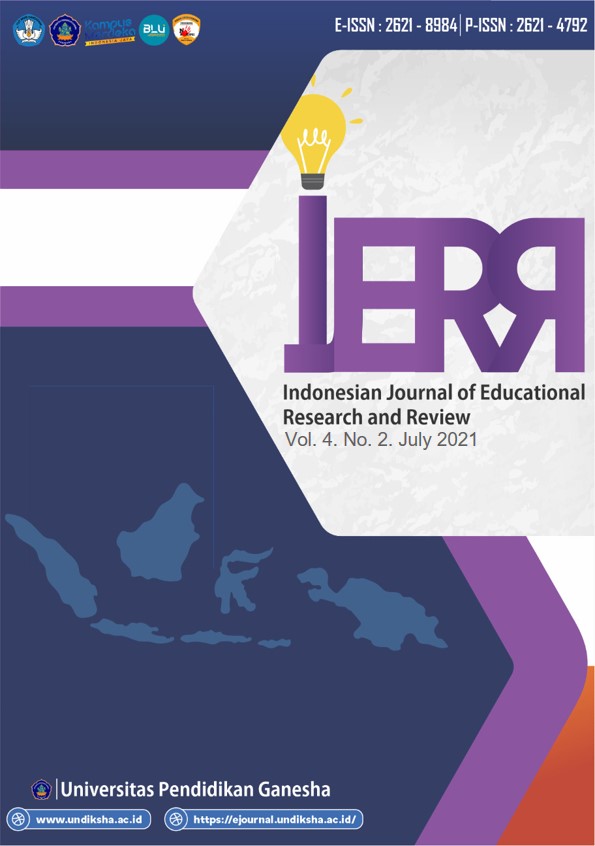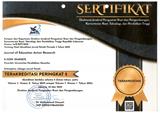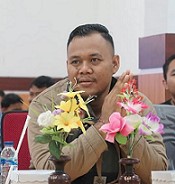Utilization of Quizizz Educational Game Media to Increase Learning Interest and Achievement
DOI:
https://doi.org/10.23887/ijerr.v4i2.30690Keywords:
Game Quizizz, Saintifik, Minat dan Prestasi BelajarAbstract
When explaining the material, the teacher only uses blackboard learning media and is monotonous. This has an impact on student learning outcomes are low. This study aims to analyze the effectiveness of the Quizizz Game learning media in increasing enthusiasm and learning outcomes. This type of research is classroom action research. The research subjects were fourth-grade students with 23 students. The data in this study were obtained through pretest, post-test questions contained in the Quizizz Game application from observations and documentation. The instruments used to collect data are questionnaires and tests. The technique used to analyze the data is descriptive qualitative and quantitative analysis. The results of the study were that students obtained a percentage of learning completeness of 43.47%. After being given action I, the average score was 72, with a learning completeness percentage of 60.86% in Cycle I. In Cycle II, the average score increased to 85 with a learning completeness percentage of 95.65%. From the analysis above, it can be concluded that the application of the Quizizz Game learning media can increase students' interest and learning achievement. This research implies that teachers can use the application of the Quizizz Game learning media to increase student interest and learning outcomes.
References
Agung, A. A. G., Widiana, I. W., & Indrasuari, N. K. S. (2017). Pengembangan Aktivitas Pembelajaran Mengasosiasi Berbasis Media Gambar Berseri Dalam Meningkatkan Proses Kognitif Siswa. Jurnal Ilmiah Sekolah Dasar, 1(3), 138. https://doi.org/10.23887/jisd.v1i3.10323
Albert, P. (2018). Digital Games - a Magical Learning Tool for Slow Learners. International Journal of Research -Granthaalayah, 6(5), 407–412. https://doi.org/10.29121/granthaalayah.v6.i5.2018.1468
Andriyani, N. L., & Suniasih, N. W. (2021). Development Of Learning Videos Based On Problem-Solving Characteristics Of Animals And Their Habitats Contain in Science Subjects On 6th-Grade. Journal of Education, 5(1), 37–47. https://doi.org/10.23887/jet.v5i1.32314
Anwar, A. I., & Zulkifli, A. (2020). The influence of demonstration method education in the knowledge of tooth brushing in children age 10–12 years. Enfermería Clínica, 30(2). https://doi.org/10.1016/j.enfcli.2019.07.132
Ardini, L., Iswara, U. S., & Retnani, E. D. (2020). Efektivitas Penggunaan E-Learning Sebagai Media Pembelajaran Saat Pandemi Covid 19. JKBM:Jurnal Konsep Bisnis Dan Manajemen, 7(1), 72–81. https://doi.org/10.31289/jkbm.v7i1.4333
Arifudin, D., Sulistyaningsih, E., & Kautsar, intan adila. (2019). Optimization of The Digital Game Based Learning Instructional Design (DGBL-ID) Method as Learning Support Media. Jurnal Mantik, 3(2), 10–19. https://iocscience.org/ejournal/index.php/mantik/article/view/1092/756
Bergdahl, N., Nouri, J., & Fors, U. (2020). Disengagement, engagement and digital skills in technology-enhanced learning. Education and Information Technologies, 25(2), 957–983. https://doi.org/10.1007/s10639-019-09998-w
Bettencourt, C., Velho, J. L., & Almeida, P. A. (2011). Biology teachers’ perceptions about Science-Technology-Society (STS) education. Procedia - Social and Behavioral Sciences, 15. https://doi.org/10.1016/j.sbspro.2011.04.262
Chiva-Bartoll, O., Ruiz-Montero, P. J., Olivencia, J. J. L., & Grönlund, H. (2021). The effects of service-learning on physical education teacher education: A case study on the border between Africa and Europe. SAGE Journals. https://doi.org/10.1177/1356336X211007156
Chu, F., Cheng, X., Peng, C., Jia, R., & Chen, T. (2021). A process transfer model-based optimal compensation control strategy for batch process using just-in-time learning and trust region method. Journal of the Franklin Institute, 358(1). https://doi.org/10.1016/j.jfranklin.2020.10.039
Dinayusadewi, N. P., Ngurah, G., & Agustika, S. (2020). Development Of Augmented Reality Application As A Mathematics Learning Media In Elementary School Geometry Materials. Journal of Education Technology, 4(2), 204–210. https://doi.org/10.23887/jet.v4i2.25372
Dwigustini, R., & Widiya, J. (2020). Think Pair Share Technique to Promote Students’ Reading Comprehension. Jurnal Ilmu Pendidikan, 12(1). https://doi.org/10.37640/jip.v12i1.270
Fauyan, M. (2019). Developing Interactive Multimedia Through Ispring on Indonesian Learning with the Insight Islamic Values in Madrasah Ibtidaiyah. Al Ibtida: Journal Pendidikan Guru MI, 6(2). https://doi.org/10.24235/al.ibtida.snj.v6i2.4173
Gabriele, K. M., Holthaus, R. M., & Boulet, J. R. (2016). Usefulness of Video-Assisted Peer Mentor Feedback in Undergraduate Nursing Education. Clinical Simulation in Nursing, 12(8), 337–345. https://doi.org/10.1016/j.ecns.2016.03.004
Gunawam, G., Harjono, A., & Sutrio, S. (2015). Multimedia Interaktif dalam Pembelajaran Konsep Listrik Bagi Calon Guru. Jurnal Pendidikan Fisika Dan Teknologi, 1(1), 9–14. https://doi.org/10.29303/jpft.v1i1.230
Gunawan, G., Sahidu, H., Harjono, A., & Suranti, N. M. Y. (2017). The effect of project based learning with virtual media assistance on student’s creativity in physics. Jurnal Cakrawala Pendidikan, 2. https://doi.org/10.21831/cp.v36i2.13514
Hamid, R., Baharom, S., Taha, M. R., & Kadaruddin, L. K. (2013). Competition as an Innovative Student-centered Learning Method for Open-ended Laboratory Work. Procedia - Social and Behavioral Sciences, 10. https://doi.org/10.1016/j.sbspro.2013.10.726
Hanif, M. (2020). The development and effectiveness of motion graphic animation videos to improve primary school students’ sciences learning outcomes. International Journal of Instruction, 13(4), 247–266. https://doi.org/10.29333/iji.2020.13416a
Hardiyanti, Y., Husain, M. S., & Nurabdiansyah. (2019). Perancangan Media Pengenalan Warna Untuk Anak Usia Dini. Jurnal Imajinasi Seni Dan Pendidikan, 2(2). https://doi.org/10.26858/i.v2i2.9553
Hashim, H. (2018). Application of Technology in the Digital Era Education. International Journal of Research in Counseling and Education, 1(2), 1. https://doi.org/10.24036/002za0002
Herbert, V. M., Perry, R. J., LeBlanc, C. A., Haase, K. N., Corey, R. R., Giudice, N. A., & Howell, C. (2021). Developing a Smartphone App With Augmented Reality to Support Virtual Learning of Nursing Students on Heart Failure. Clinical Simulation in Nursing, 54. https://doi.org/10.1016/j.ecns.2021.02.003
Hermanto, Y. B., Agustini, V., & Srimulyani. (2021). The Challenges of Online Learning During the Covid-19 Pandemic. Jurnal Pendidikan Dan Pengajaran, 54(1). https://doi.org/10.23887/jpp.v54i1.29703
Hermawan, Putro, K. H., & Sugini. (2018). The Effectiveness of Course Review Horay Method on Social Sciences Learning Achievement of Visually Impaired Students. Journal of Icsar, 2(2). https://doi.org/10.17977/um005v2i22018p153
Huang, S. Y., Kuo, Y. H., & Chen, H. C. (2020). Applying digital escape rooms infused with science teaching in elementary school: Learning performance, learning motivation, and problem-solving ability. Thinking Skills and Creativity, 37(129), 100681. https://doi.org/10.1016/j.tsc.2020.100681
Hwang, G. J., Wu, P. H., & Chen, C. C. (2012). An online game approach for improving students’ learning performance in web-based problem-solving activities. Computers and Education, 59(4), 1246–1256. https://doi.org/10.1016/j.compedu.2012.05.009
Ivanov, D., Dolgui, A., & Sokolov, B. (2019). The impact of digital technology and Industry 4.0 on the ripple effect and supply chain risk analytics. International Journal of Production Research, 57(3), 829–846. https://doi.org/10.1080/00207543.2018.1488086
Jatmiko, A., Kartina, Y., Irwandani, I., Fakhri, J., Pricilia, A., & Rahayu, T. (2018). Reading Concept Map-Think Pair Share (Remap-TPS) Learning Model on Cognitive Ability and Scientific Attitude. Jurnal Keguruan Dan Ilmu Tarbiyah, 3(2). https://doi.org/10.24042/tadris.v3i2.3184
Karasmanaki, E., & Tsantopoulos, G. (2021). Impacts of social distancing during COVID-19 pandemic on the daily life of forestry students. Children and Youth Services Review, 120(December 2020), 105781. https://doi.org/10.1016/j.childyouth.2020.105781
Katz, C., Priolo Filho, S. R., Korbin, J., Bérubé, A., Fouché, A., Haffejee, S., Kaawa-Mafigiri, D., Maguire-Jack, K., Muñoz, P., Spilsbury, J., Tarabulsy, G., Tiwari, A., Thembekile Levine, D., Truter, E., & Varela, N. (2020). Child maltreatment in the time of the COVID-19 pandemic: A proposed global framework on research, policy and practice. Child Abuse and Neglect, November, 1–14. https://doi.org/10.1016/j.chiabu.2020.104824
Kim, P., Buckner, E., Kim, H., & Makany, T. (2012). A comparative analysis of a game-based mobile learning model in low-socioeconomic communities of India. International Journal of Educational Development, 3(2). https://doi.org/10.1016/j.ijedudev.2011.05.008
Le, T. T. H., Tran, T., Trinh, T. P. T., Nguyen, C. T., Nguyen, T. P. T., Vuong, T. T., Vu, T. H., Bui, D. Q., Vuong, H. M., Hoang, P. H., Nguyen, M. H., Ho, M. T., & Vuong, Q. H. (2019). Reading habits, socioeconomic conditions, occupational aspiration and academic achievement in Vietnamese junior high school students. Sustainability (Switzerland), 11(18), 1–29. https://doi.org/10.3390/su11185113
Li, F.-Y., Hwang, G.-J., Chen, P.-Y., & Lin, Y.-J. (2021). Effects of a concept mapping-based two-tier test strategy on students’ digital game-based learning performances and behavioral patterns. Computers & Education, 24. https://doi.org/10.1016/j.compedu.2021.104293
Lim, M. T. C., Ramamurthy, M. B., Aishworiya, R., Rajgor, D. D., Tran, A. P., Hiriyur, P., Kunaseelan, S., Jabri, M., & Goh, D. Y. T. (2021). School closure during the coronavirus disease 2019 (COVID-19) pandemic – Impact on children’s sleep. Sleep Medicine, 78(January 2020), 108–114. https://doi.org/10.1016/j.sleep.2020.12.025
Maryanti, S., & Kurniawan, D. T. (2018). Pengembangan Media Pembelajaran Video Animasi Stop Motion Untuk Pembelajaran Biologi Dengan Aplikasi Picpac. Jurnal BIOEDUIN : Program Studi Pendidikan Biologi, 8(1), 26–33. https://doi.org/10.15575/bioeduin.v8i1.2922
Masturah, E. D., Mahadewi, L. P. P., & Simamora, A. H. (2018). Pengembangan Media Pembelajaran Pop-Up Book pada Mata Pelajaran IPA Kelas III Sekolah Dasar. Jurnal EDUTECH Universitas Pendidikan Ganesha, 6(2), 212–221. https://doi.org/10.23887/jeu.v6i2.20294
Muhtar, T., & Dallyono, R. (2020). Character Education From the Perspectives of Elementary School Physical Education Teachers. Jurnal Cakrawala Pendidikan, 39(2), 395–408. https://doi.org/10.21831/cp.v39i2.30647
Ntobuo, N. E., Arbie, A., & Amali, L. N. (2018). The Development of Gravity Comic Learning Media Based on Gorontalo Culture. Jurnal Pendidikan IPA Indonesia, 7(2), 246–251. https://doi.org/10.15294/jpii.v7i2.14344
Partovi, T., & Razavi, M. R. (2019). The effect of game-based learning on academic achievement motivation of elementary school students. Learning and Motivation, 68. https://doi.org/10.1016/j.lmot.2019.101592
Pratama, D., Wardani, W. G. W., & Akbar, T. (2018). The Visual Elements Strength in Visual Novel Game Development as the Main Appeal. MUDRA: Jurnal Seni Budaya, 3(3). https://doi.org/10.31091/mudra.v33i3.455
Priantini, D. A. (2020). The Development Of Teaching Video Media Based On Tri Kaya Parisudha In Educational Psychology Courses. Journal of Education Technology, 4(4). https://doi.org/10.23887/jet.v4i4.29608
Safitri. (2020). Pengembangan Media Board Game untuk Pembelajaran Tematik di Sekolah Dasar. Jurnal Inovasi Pembelajaran, 6(2). https://doi.org/10.22219/jinop.v6i2.8186
Saiboon, I. M., MSurg, Nurmaimun, Noriani, Shamsuddin, N. S., & Johar, M. (2021). Effectiveness of Self-Directed Small-Group-Learning Against Self-Directed Individual-Learning Using Self-Instructional-Video in Performing Critical Emergency Procedures Among Medical Students in Malaysia: A Single-Blinded Randomized Controlled Study. Clinical Simulation in Nursing, 56(1). https://doi.org/10.1016/j.ecns.2021.02.006
Sert, N., & Boynueğri, E. (2017). Digital technology use by the students and english teachers and self-directed language learning. World Journal on Educational Technology: Current Issues, 9(1), 24. https://doi.org/10.18844/wjet.v9i1.993
Shaik Alavudeen, S., Easwaran, V., Iqbal Mir, J., Shahrani, S. M., Ali Aseeri, A., Abdullah Khan, N., Mohammed Almodeer, A., & Abdullah Asiri, A. (2021). The influence of COVID-19 related psychological and demographic variables on the effectiveness of e-learning among health care students in the southern region of Saudi Arabia. Saudi Pharmaceutical Journal. https://doi.org/10.1016/j.jsps.2021.05.009
Shih, Y.-C., & Reynols, B. L. (2015). Teaching Adolescents EFL by Integrating Think-Pair-Share and Reading Strategy Instruction: A Quasi-Experimental Study. RELC Journal, 6(1). https://doi.org/10.1177/0033688215589886
Smutny, P., & Schreiberova, P. (2020). Chatbots for learning: A review of educational chatbots for the Facebook Messenger. Computers & Education, 151. https://doi.org/10.1016/j.compedu.2020.103862
Turgut, S., & Turgut, I. G. (2018). The effects of cooperative learning on mathematics achievement in Turkey: A meta-analysis study. International Journal of Instruction, 11(3), 663–680. https://doi.org/10.12973/IJI.2018.11345A
Utami, T. N., Jatmiko, A., & Suherman, S. (2018). Pengembangan Modul Matematika dengan Pendekatan Science, Technology, Engineering, And Mathematics (STEM) pada Materi Segiempat. Desimal: Jurnal Matematika, 1(2), 165. https://doi.org/10.24042/djm.v1i2.2388
Wu, T. T., & Wu, Y. T. (2020). Applying project-based learning and SCAMPER teaching strategies in engineering education to explore the influence of creativity on cognition, personal motivation, and personality traits. Thinking Skills and Creativity, 35(January), 100631. https://doi.org/10.1016/j.tsc.2020.100631
Wulandari, T. A. J., Sibuea, A. M., & Siagian, S. (2019). Pengembangan Media Pembelajaran Berbasis Multimedia Interaktif Pada Mata Pelajaran Biologi. Jurnal Teknologi Informasi & Komunikasi Dalam Pendidikan, 5(1), 75–86. https://doi.org/10.24114/jtikp.v5i1.12524
Wungguli, D., & Yahya, L. (2020). Pengaruh Penggunaan Media Berbasis Information and Communication Technology (ICT) terhadap Hasil Belajar Siswa pada Materi Dimensi Tiga. Jambura Journal of Mathematics Education, 1(1), 41–47. https://doi.org/10.34312/jmathedu.v1i1.5376
Wuryanti. (2016). Pengembangan Media Video Animasi untuk Meningkatkan Motivasi Belajar dan Karakter Kerja Keras Siswa Sekolah Dasar. Jurnal Pendidikan Karakter, 6(2). https://doi.org/10.21831/jpk.v6i2.12055.
Yildiz, S., & Ersan, Y. (2011). A study on pc - video games in terms of the space awareness from childhood to youth. Procedia - Social and Behavioral Sciences, 28. https://doi.org/10.1016/j.sbspro.2011.11.145
Yulando, S., Sutopo, S., & Franklin Chi, T. (2019). Electronic Module Design and Development: An Interactive Learning. American Journal of Educational Research, 7(10), 694–698. https://doi.org/10.12691/education-7-10-4
Yusuf, I., & Widyaningsih, S. W. (2020). Implementing e-learning-based virtual laboratory media to students’ metacognitive skills. International Journal of Emerging Technologies in Learning, 15(5). https://doi.org/10.3991/ijet.v15i05.12029
Zhao, Y., Llorente, A. M. P., & Gómez, M. C. S. (2021). Digital competence in higher education research: A systematic literature reviewNo Title. Computers & Education, 168. https://doi.org/10.1016/j.compedu.2021.104212
Downloads
Published
How to Cite
Issue
Section
License
Authors who publish with the Indonesian Journal of Educational Research and Review (IJERR) agree to the following terms:
- Authors retain copyright and grant the journal the right of first publication with the work simultaneously licensed under a Creative Commons Attribution License (CC BY-SA 4.0) that allows others to share the work with an acknowledgment of the work's authorship and initial publication in this journal.
- Authors are able to enter into separate, additional contractual arrangements for the non-exclusive distribution of the journal's published version of the work (e.g., post it to an institutional repository or publish it in a book), with an acknowledgment of its initial publication in this journal.
- Authors are permitted and encouraged to post their work online (e.g., in institutional repositories or on their website) prior to and during the submission process, as it can lead to productive exchanges, as well as earlier and greater citation of published work. (See The Effect of Open Access)












